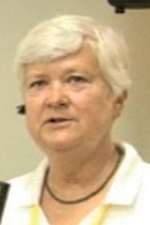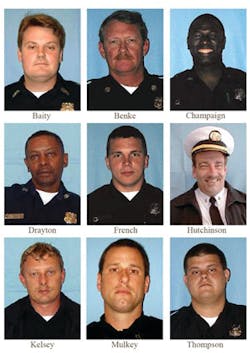CHARLESTON, S.C. -- Had automatic sprinklers been in place, the fire at the Sofa Super Store would have been confined to the loading dock area where the fire started, NIST investigators said Thursday.
Volume II of NIST Report (PDF)
Also, the smashing of the front windows 24 minutes into the incident provided oxygen to the slow-moving fire, which then rapidly spread, explained Nelson Bryner, who led the investigation.
Through modeling, examination of debris, construction as well as the contents of the furniture store, interviews, photographs and videos, NIST engineers pieced together how the deadly fire spread.
For nine Charleston firefighters, the June 18, 2007 call was their final alarm.
Killed were Captains Billy Hutchinson, Mike Benke, and Louis Mulkey; Engineers Mark Kelsey and Brad Baity, Assistant Engineer Michael French; and Firefighters Earl Drayton, Melvin Champaign and Brandon Thompson.
On Thursday morning, NIST officials met first with the families of the firefighters, then the fire department. The document was released at noon online as a press conference started.
NIST investigators were on the scene in Charleston before the ashes were cold. They worked side-by-side with ATF, fire marshals and others in case they were called upon to conduct an analysis.
Following their extensive analysis, NIST officials determined that the high fuel load (furniture), lack of sprinklers, the open floor plan, and hidden build-up of combustible smoke and gases in the area between the drop ceiling and roof of the main showroom were among the factors in the fire's fast progress.
The report also stated that after the window was broken, the fire swept from the rear to the front of the main showroom extremely quickly, then into the west and east showrooms, trapping six firefighters in the main showroom and three firefighters in the west showroom.
They made 11 recommendations following their probe including the installation of automatic sprinklers; the adoption and enforcement of building and life safety codes and the establishment of regulations about ventilation procedures.
Unlike two previous reports, the NIST document was scientific. There was no finger-pointing. Instead, investigators used physics, engineering, measurements to determine fire behavior, movement and characteristics.
The probe by a panel of national fire service experts pulled no punches. They blamed the culture of the Charleston Fire Department for the deadly outcome.
They cited lack of leadership, training, building code violations, communications problems and water issues as major factors in the tragic deadly blaze.
They also noted that sprinklers would have made a difference.
The group -- led by Gordon Routley -- dedicated their analysis, believed to be the most comprehensive reviews ever, to the Charleston 9.
They did a minute by minute timeline, tracking the actions of the firefighters and the locations of the apparatus. They conducted interviews with firefighters who were there, and listened to radio transmissions, some of which were heard by others but missed on the fire ground.
The Routley panel concluded: "The Charleston Fire Department was inadequately staffed, inadequately trained, insufficiently equipped, and organizationally unprepared to conduct an operation of this complexity in a large commercial occupancy."
"The final analysis of this incident does not suggest that any of the firefighters who lost their lives, or any of the surviving members of the Charleston Fire Department, failed to perform their duties as they had been trained or as expected by their organization. The analysis indicates that the Charleston Fire Department failed to adequately prepare its members for the situation they encountered at the Sofa Super Store Fire."
The NIOSH report echoed the same issues and concerns.
Among other things, the investigators also suggested that the department develop, implement and enforce written standard operating procedures (SOPs) for an occupational safety and health program in accordance with NFPA 1500. They also said that an incident commander needed to be clearly identified as the person responsible at an incident.
More on Charleston Super Sofa Store Fire:

Susan Nicol | News Editor
Susan Nicol is the news editor for Firehouse.com. She is a life member and active with the Brunswick Volunteer Ambulance & Rescue Company, Oxford Fire Company and Brunswick Vol. Fire Co. Susie has been an EMT in Maryland since 1976. Susie is vice-president of the Frederick County Fire/Rescue Museum. She is on the executive committee of Frederick County Volunteer Fire and Rescue Association. She also is part of the Maryland Institute for Emergency Medical Services Systems (MIEMSS) Region II EMS Council. Susie is a board member of the American Trauma Society, Maryland Division. Prior to joining the Firehouse team, she was a staff writer for The Frederick News-Post, covering fire, law enforcement, court and legislative issues.






